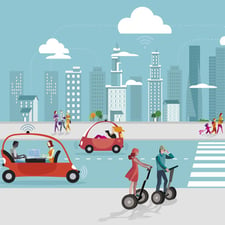
By 2025, fully autonomous vehicles—aka driverless cars— will be available to the general public. And by 2035, the need for parking will likely decline by more than 5.7 billion square meters in the U.S., says McKinsey & Co. That’s half the size of Connecticut!
At present, cars spend 95 percent of their existence parked. With the promise of driverless cars and subscription-based fleets, however, experts are predicting that vehicles will spend more and more time on the road transporting fleet riders from place to place. This, no doubt, will alter many aspects of commercial real estate. Let’s take a look at six ways driverless cars will impact CRE in the very near future.
-
Retail center tenants will change; shopping and distribution opportunities arise.
Regional and super regional malls have become more mixed-use in nature over the last decade, and the trend will accelerate with self-driving cars. Moving forward, all retail centers will likely offer more entertainment options to make up for the vacancies of traditional retailers, which have been losing the battle against online shopping. The good news is: retailers may see an increase in business as parking and getting in and out of stores becomes quicker and less of a headache, enticing people to make the visit. Parking lot footprints will shrink; usable space will increase; outside maintenance will decrease, and so will overhead, lowering rent and making it more likely for tenants to survive. We may even see tenants that sell groceries take advantage of driverless cars, too, and use their stores as distribution centers for home deliveries, shifting space from floor retail to logistical operations.
-
Hotels will see a decline in overnighters.
The increase in driverless cars is going to change travel patterns and impact select and limited service hotels. What does this mean? A major percentage of these hotels are located in rural areas, adjacent to highway intersections that link to main routes. As driverless cars become more common, travelers may be more inclined to let the vehicles take them to their final destinations—as they relax or sleep in them—rather than break up the drive and stay overnight at hotels.
-
Properties with available space become investment opportunities.
Sites with additional buildable space could become opportunities for investment. As driverless vehicles become more prevalent, fewer parking spots will be required. As a result, there will be opportunity to buy retail centers close to Central Business Districts that have large surface lots. The intent: building new structures in the existing parking lots or demolishing the existing structures and building new ones.
-
Parking space will be uncoupled from existing buildings and redesigned for productive use.
Office buildings: Central Business District office buildings with attached or integrated parking garages will be impacted most significantly. If there is zero demand for on-site parking, this space will go unused or may be converted into loading/unloading space.
The configuration and proximity of driverless car loading/unloading zones will also impact the design of Central Business District office buildings with the addition of designated, centralized loading stations similar to subway stations. It may even be possible to convert parking spaces into these loading zones.
The impacts on suburban office building design will be minimal, however, as they are already designed for access by car and have ample areas for loading/unloading.
Multifamily developments: Many multifamily developments already have a surplus of parking. Driverless car usage will make this surplus more ubiquitous. With luck, garden-style apartment complexes may be able to absorb their excess parking space by building more units, installing additional amenities, or selling off excess parking space as retail sites.
Hotels: The design impacts driverless vehicles will have on lodging are similar to those on multifamily dwellings. Select and limited service hotels might able to monetize their surplus parking by adding more rooms or by selling off the space for ancillary development.
Converting the integrated parking areas with existing mid- and high-rise hotel buildings will be more difficult. Possible uses include converting some of the space into passenger loading and offloading areas, renting the space for storage, or installing additional building amenities within the space.
Retail Centers: As mentioned earlier, community and neighborhood retail centers anchored by grocery stores will most likely see the size of their parking lots shrink as more shoppers arrive by vehicles apart of shared fleets.
-
New developments will become denser and built closer to roads.
Suburban office parks and shopping centers: The design impacts on office buildings will likely vary depending on location. While driverless cars may decrease a tenant’s demand for suburban office buildings more so than Central Business District office buildings, the design impacts they will have on suburban office buildings will likely be minor. The typical suburban office building that is part of an office park is already designed for access by car, and has ample areas for loading and offloading. Suburban office parks built to accommodate vehicular traffic will likely continue to become denser and more mixed-use in nature. New buildings within new or existing office parks will likely to be built closer to the road and one another; the land vacated by parking could increase building density. Shopping centers, like office buildings, will likely be built closer to the road.
-
New developments will be designed for transition and decrease development costs.
Driverless cars will shift how developments are zoned, laid out, and constructed. Parking garages in these developments will be designed with the transition toward self-parking cars in mind. Because these smart vehicles require smaller spaces (as they can be parked closer together since people won’t need to squeak out of them), it will lessen associated development costs and open up additional square footage for usable space. These garages will also be designed for the predicted transition to subscription services to intelligent fleets. For example, garage ceilings will be heightened in anticipation that it will be later used for residential or commercial use rather than parking space.
Conclusions
Self-driving cars are presenting exciting new challenges and opportunities to the commercial real estate industry. As the cost of private transportation decreases, the necessity of vehicle ownership becomes less in vogue, more miles will be traveled by shared fleets like Uber. Much of the value in real estate is shaped by location, the environment built around it, and access. Real estate values will respond as the rules of access are rewritten by the advent of intelligent cars. Since real estate is typically viewed as a long-term, relatively liquid investment, investors should take these future realities into consideration when buying, selling, and developing new properties.

%20wide%20high%20res.png?width=270&height=270&name=SLN%20Since%201906%20(Blue)%20wide%20high%20res.png)